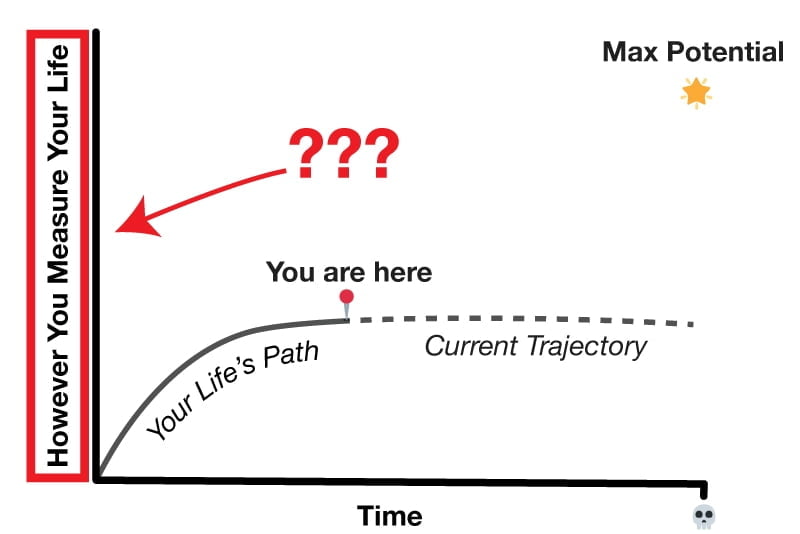How do you measure success in your life?
It’s a simple question that almost nobody has a good answer to—or at least an answer that’s working for them.
So let’s try to change that. Let’s see if you can’t begin to figure out how to measure success in your life with the help of a simple chart, some basic guidelines, and a few thought experiments.
Because the better your answer the better you can make decisions that guide you in the right direction.
Video version for people who don’t read good.
This is your ultimate goal.
To illustrate what I mean by “better,” consider this simple chart of your life’s path:

As you can see, time is on the horizontal x-axis. At its endpoint (your death), way up high, is a star. That star marks your life’s “Max Potential.”
Your Max Potential is the highest possible score you can reach in the game of life.
If you were to reach your Max Potential, you’d think to yourself on your deathbed, “Wow! My life turned out the best it could have possibly been. Every decision I made was perfe…CROAK.”
Everyone’s Max Potential differs based on factors like your lifespan, upbringing, genetics, and how well you adhere to The Zag’s wisdom. Most of these factors are out of your control, but one—maybe the biggest one—doesn’t:
The measure you decide to use to keep score in the game of life.
In other words, what’s your y-axis on this chart of your life’s path?
That’s your definition of “better.”

Pick your measurement.
Your y-axis is how you measure whether you’re winning at life, coasting through it, or losing your way.
Nobody but you can decide what your y-axis is. If you don’t consciously pick something, you’re destined to continue making suboptimal life decisions that lead you away from your Max Potential.
Why?
Because your subconscious will take the reins.
Your subconscious sucks at decision-making. It’s highly emotional, competitive, and short-sighted. It goes after the bright and shiny objects it can see, like money, sex, power, and pizza. And it seeks emotions it can feel now, like relaxation, intoxication, and relief.
Now, you probably haven’t been stupid enough to let your subconscious run the show up until you. You probably managed to hold it off and engage your conscious on important life decisions.
But ask yourself this:
Have your conscious decisions consistently taken you toward the same Max Potential?
Probably not because if you were you wouldn’t be reading this now. Even your conscious decisions were probably made based on an inconsistent collection of success measures.
So pick a consistent y-axis. Wouldn’t you have an easier time making decisions that way?
If you suspect so, here’s how to start.
Keep it simple, stupid.
Your perfect y-axis is probably not one single measure but a convoluted concoction of inputs like love, truth, balance, fun, growth, or whatever.
So why not try to find that perfect mix?
Because your conscious would soon get exhausted trying to cater every life decision to it. And when your conscious takes a rest, guess what takes over?
Your subconscious.
So even with a “perfect” y-axis, you’d end up following subconscious urges to chase butterflies, big bucks, and booty instead of making a rewarding climb toward your max potential.
This is why you’re probably better off with a simple rule-of-thumb y-axis that your conscious can use quickly and tirelessly to guide better life decisions.
Something simple’s better than nothing.
“The unattainable best is the enemy of all available betters.”
Bill Burnett
Don’t feel the need to find a perfect y-axis. Don’t even worry about finding a great one to start.
Satisfice.
Settle on something imperfect but easy that your conscious can use to guide you in approximately the direction of your Max Potential. As long as you don’t pick something too stupid to start, your rough-draft y-axis will help you make better decisions than you’d make without one.
You can always fine-tune it as you go along.
How do you find a y-axis to settle on?
Try these exercises.
They helped me come up with a not-too-shabby y-axis (Growth) and did the trick for the forty-odd people in the first cohort of the 30-Day Redirect. (Examples included Flow, Balance, Understanding, and Peace.)
Hopefully they’ll help you hone in on something that works for you, too.

1. Deconstruct your hits and misses.
Ask yourself:
- What are your absolute favorite things to do that never go stale?
- What do you most hate doing?
- What are your proudest accomplishments so far in your life?
- What are your biggest regrets?
Then for everything you came up with, ask yourself, “Why?” Why did you choose them and not others? Look among these reasons for common threads. They will hint at what your y-axis is.

2. Figure out what’s in your way.
One of my favorite questions for finding a job you love and finding meaning and motivation in life is:
What’s a problem or injustice in the world that riles your up but that most everyone else doesn’t seem to care about?
Your answer, your problem, is like an incessant headwind. You can moan and groan about it as it pushes you backward in life. Or you can use it to fill your sails for a self-actualizing adventure toward your Max Potential.
If you think you have some idea of what could be your problem, ask yourself this:
What’s its opposite?
That’ll give you a good indication of what your y-axis is.

3. Strategize your game of life.
How would you define “winning at the game of life”?
If you can do so, you can work backward to figure out how to keep score. That’s your y-axis!
It might also help to ask yourself:
Who’s winning at the game of life I’m trying to play?
For whoever comes to mind, try to figure out why you picked that person. In what measures have they scored big points in the game of life that you’d like to score, too? One of those could hint at your y-axis.

4. Do some thought-experimenting.
Here are some imaginary scenarios and perspective shifts that might wiggle your thinking free when it’s stuck:
What if you had unlimited money and eternal youth?
By removing time and money, the two worst excuses people make for not climbing toward their Max Potential, you can hone in on what matters.
What y-axis would you recommend to someone else?
Think of your best friend or favorite child. What y-axis do you think they should use? Is there any reason you shouldn’t be using the same?
What y-axis would your past and future selves agree on?
Imagine you had a y-axis brainstorming session with your past self who’s half your age and your future self who’s twice your age. What might all three of you be able to agree on?
Sense check your y-axis.
Since the idea is to use your y-axis to guide your life decisions, you better not settle on something silly that will lead every subsequent choice astray.
To be safe, ensure whatever you settle on meets the following criteria
- Straightforward. As we already saw, if your y-axis is too complicated, your conscious will tire of using it and your subconscious will take over.
- Uncompetitive. Life’s not a competition. If you have to beat others to move you up your y-axis, your success partly depends on their performance. But you can’t control others’ performance. Not having full control of your life’s path is not good.
- Accumulative. Past successes should not fade away with time. They should build on each other—or even compound. This way, short-term and long-term rewards are aligned.
- Ceiling-less. You should be able to keep climbing higher and higher up your y-axis your life’s path without ever maxing out or leveling off.
You better decide.
The sooner you decide on your y-axis to measure success in your life, the more time you’ll have to direct your life’s path up to your Max Potential.
So satisfice.
Use it to guide your decisions.
And push yourself to start racking up more points in the game of life.
About the author
👋 I'm Chris. Everything you read on TheZag.com is my fault. This site is like a gym for your comfort zone, full of challenges to make your status quo sexier. Join my 'Consider This' newsletter for a fun new challenge every 10 days. Try it!




Leave a Comment